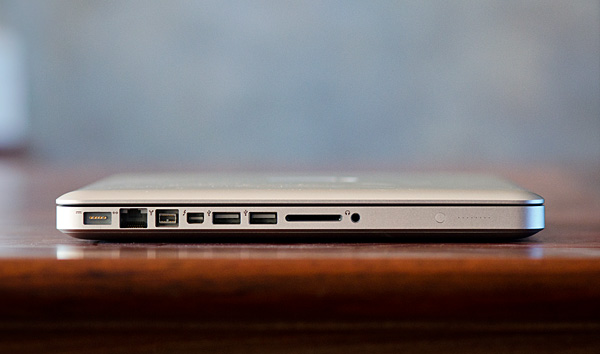The MacBook Pro Review (13 & 15-inch): 2011 Brings Sandy Bridge
by Anand Lal Shimpi, Brian Klug & Vivek Gowri on March 10, 2011 4:17 PM EST- Posted in
- Laptops
- Mac
- Apple
- Intel
- MacBook Pro
- Sandy Bridge
Final Words
For as little attention as the 2011 MacBook Pro launch was given by Apple, there sure is a lot to talk about.
The advantages are numerous. With the 13-inch MacBook Pro, under OS X at least, there simply aren't any downsides. You get much better CPU performance over the previous generation. In fact, the new 13 can outperform last year's 15 thanks to Sandy Bridge. The new 13 is quite possibly the best balance of portability and performance. It's the single largest upgrade you'll find in the lineup. If you own a previous generation 13-inch MBP, the upgrade is 100% worth it. Graphics performance is solid under OS X however questionable under Windows. For some reason we actually saw a step back in GPU performance vs. last year's 13-inch MBP when running games in Windows 7.
The 15-inch MacBook Pro is a beast. Although it comes in the same chassis as last year's model, it delivers much more performance. The move to quad-core Sandy Bridge makes the 15-inch MacBook Pro's performance formidable. Whereas I couldn't use the 2010 15 as my primary work machine, with an SSD the 2011 15-inch MBP does just fine.
Displays haven't really changed, which is both good and bad. On the one hand, Apple's MacBook Pros have always used good quality panels. On the other hand I'd like to see a higher res option for the 13-inch display—1280 x 800 is a big turnoff for me with the 13-inch model.
Thunderbolt is a nice addition however I expect that it'll be grossly underused for a while. We'll see some nice Thunderbolt enabled external storage solutions this Spring (helping perpetuate the mobile desktop usage model), but it'll be a while before we get the single-cable carrying USB, Ethernet, FireWire and DisplayPort to a display.
The WiFi improvements are welcome, although surprisingly absent from Apple's marketing collateral. The front facing 720p camera is also a nice touch.
It's not all rosy however. Apple fails to really take advantage of one of Sandy Bridge's biggest features: Quick Sync. The hardware encoder is used in FaceTime HD but you still get some very high CPU usage (at least of a single core). There's no support in QuickTime or iMovie 2011 for Quick Sync as of now, which is a major disappointment.
I mentioned that the 15-inch MacBook Pro is easily a desktop replacement, however you do have to deal with a loud fan under heavier CPU loads. Something a well designed desktop won't bother you with.
SSD support is still problematic. There are far too many reports of drives that don't work properly in the 2011 MacBook Pro, and Apple refuses to validate/ship anything but fairly mainstream SSD solutions. To make matters worse, although TRIM is finally enabled under OS X—it only works on Apple branded SSDs. I can understand Apple's desire to want to avoid dealing with the pitfalls of early SSDs with questionable firmware maturity, but I also believe it's Apple's duty to support as much hardware that's out there in the market today. If Apple offered something with SandForce SF-2200 class performance I'd have less of a bone to pick, but presently it doesn't.
Then there are the concerns about battery life. Under light usage there's a clear improvement over last year's models. The new 15-inch MacBook Pro is good for anywhere between 7—9 hours of light usage. That is assuming you don't have the dGPU running of course, at which point you should start talking about numbers below 5 hours. Even without the discrete GPU enabled, in the hands of a multitasker the new 15-inch MacBook Pro can easily burn through its 77Whr battery quicker than last year's model. While our worst case numbers don't look much lower than the 2010 model, the chances of you getting less than 2.5 hours out of the new 15 are much higher than they were last year.
The new 13-inch model is less of a concern when it comes to battery life. It's still got a 35W TDP dual-core CPU and no discrete GPU to sap power. It's the move to four cores and the additional GPU that really hurt the 15-inch MacBook Pro under heavy usage.
Overall the new lineup is a significant step forward. As I mentioned earlier, if you're in the market for a 13-inch system the 2011 Sandy Bridge MacBook Pro is likely the one to get. The 15 is just as easy to recommend, provided you're ok with the downsides (higher temperatures, louder fans, shorter battery life under load). If you aren't ok with the downsides, just wait another year and get the Ivy Bridge based successor.












198 Comments
View All Comments
IntelUser2000 - Friday, March 11, 2011 - link
You don't know that, testing multiple systems over the years should have shown performance differences between manufacturers with identical hardware is minimal(<5%). Meaning its not Apple's fault. GPU bound doesn't mean rest of the systems woud have zero effect.It's not like the 2820QM is 50% faster, its 20-30% faster. The total of which could have been derived from:
1. Quad core vs. Dual core
2. HD3000 in the 2820QM has max clock of 1.3GHz, vs. 1.2GHz in the 2410M
3. Clock speed of the 2820QM is quite higher in gaming scenarios
4. LLC is shared between CPU and Graphics. 2410M has less than half the LLC of 2820QM
5. Even at 20 fps, CPU has some impact, we're not talking 3-5 fps here
It's quite reasonable to assume, in 3DMark03 and 05, which are explicitely single threaded, benefits from everything except #1, and frames should be high enough for CPU to affect it. Games with bigger gaps, quad core would explain to the difference, even as little as 5%.
JarredWalton - Friday, March 11, 2011 - link
I should have another dual-core SNB setup shortly, with HD 3000, so we'll be able to see how that does.Anyway, we're not really focusing on 3DMarks, because they're not games. Looking just at the games, there's a larger than expected gap in the performance. Remember: we've been largely GPU limited with something like the GeForce G 310M using Core i3-330UM ULV vs. Core i3-370. That's a doubling of clock speed on the CPU, and the result was: http://www.anandtech.com/bench/Product/236?vs=244 That's a 2 to 14% difference, with the exception of the heavily CPU dependent StarCraft II (which is 155% faster with the U35Jc).
Or if you want a significantly faster GPU comparison (i.e. so the onus is on the CPU), look at the Alienware M11x R2 vs. the ASUS N82JV: http://www.anandtech.com/bench/Product/246?vs=257 Again, much faster GPU than the HD 3000 and we're only seeing 10 to 25% difference in performance for low detail gaming. At medium detail, the difference between the two platforms drops to just 0 to 15% (but it grows to 28% in BFBC2 for some reason).
Compare that spread to the 15 to 33% difference between the i5-2415M and the i7-2820QM at low detail, and perhaps even more telling is the difference remains large at medium settings (16.7 to 44% for the i7-2820QM, except SC2 turns the tables and leads by 37%). The theoretical clock speed difference on the IGP is only 8.3%, and we're seeing two to four times that much -- the average is around 22% faster, give or take. StarCraft II is a prime example of the funkiness we're talking about: the 2820QM is 31% faster at low, but the 2415M is 37% faster at medium? That's not right....
Whatever is going on, I can say this much: it's not just about the CPU performance potential. I'll wager than when I test the dual-core SNB Windows notebook (an ASUS model) that scores in gaming will be a lot closer than what the MBP13 managed. We'll see....
IntelUser2000 - Saturday, March 19, 2011 - link
I forgot one more thing. The quad core Sandy Bridge mobile chips support DDR3-1600 and dual core ones only up to DDR3-1333.mczak - Thursday, March 10, 2011 - link
memory bus width of HD6490M and H6750M is listed as 128bit/256bit. That's quite wrong, should be 64bit/128bit.btw I'm wondering what's the impact on battery life for the HD6490M? It isn't THAT much faster than the HD3000, so I'm wondering if at least the power consumption isn't that much higher neither...
Anand Lal Shimpi - Thursday, March 10, 2011 - link
Thanks for the correction :)Take care,
Anand
gstrickler - Thursday, March 10, 2011 - link
Anand, I would like to see heat and maximum power consumption of the 15" with the dGPU disabled using gfxCardStatus. For those of us who aren't gamers and don't need OpenCL, the dGPU is basically just a waste of power (and therefore, battery life) and a waste of money. Those should be fairly quick tests.Nickel020 - Thursday, March 10, 2011 - link
The 2010 Macbooks with the Nvidia GPUs and Optimus switch to the iGPU again even if you don't close the application, right? Is this a general ATI issue that's also like this on Windows notebooks or is it only like this on OS X? This seems like quite an unnecessary hassle, actually having to manage it yourself. Not as bad as having to log off like on my late 2008 Macbook Pro, but still inconvenient.tipoo - Thursday, March 10, 2011 - link
Huh? You don't have to manage it yourself.Nickel020 - Friday, March 11, 2011 - link
Well if you don't want to use the dGPU when it's not necessary you kind of have to manage it yourself. If I don't want to have the dGPU power up while web browsing and make the Macbook hotter I have to manually switch to the iGPU with gfxCardStatus. I mean I can leave it set to iGPU, but then I will still manually have to switch to the dGPU when I need the dGPU. So I will have to manage it manually.I would really have liked to see more of a comparison with how the GPU switching works in the 2010 Macbook Pros. I mean I can look it up, but I can find most of the info in the review somewhere else too; the point of the review is kind of to have it all the info in one place, and not having to look stuff up.
tajmahal42 - Friday, March 11, 2011 - link
I think switching behaviour should be exactly the same for the 2010 and 2011 MacBook Pros, as the switching is done by the Mac OS, not by the Hardware.Apparently, Chrome doesn't properly close done Flash when it doesn't need it anymore or something, so the OS thinks it should still be using the dGPU.